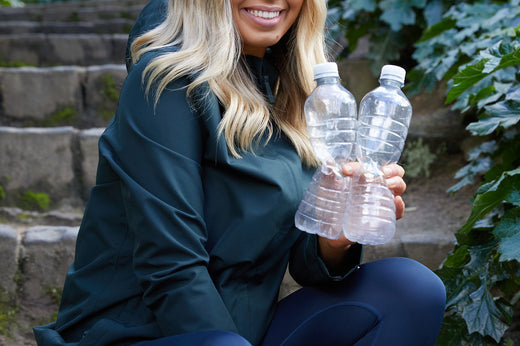How are Plastic Bottles Recycled into Clothing?

When you first hear that fabric can be made from recycled plastic bottles, it’s a pretty wild concept to wrap your head around. Understandably your first thoughts are wondering if the fabric is hot, crunchy and anything but breathable. TL;DR it’s not, it’s soft, breathable and sustainable. Now before we jump into why recycling plastic bottles is a good thing and how on earth it actually happens, we’ll present another predominantly unknown fact; the majority of your clothing is made from oil.
To try and sum up the different fabric types briefly, there’s natural and synthetic fibres. Natural fibres include cotton, silk, linen, wool, hemp and bamboo, they’re grown (either by plants or animals) and they’re biodegradable, with a lighter impact. Then there’s synthetic fibres, these are man made fibres, including polyester, nylon, acrylic and spandex, these are made from non natural materials, historically from oil.
So why would we ever use synthetics if we can just use natural fibres? Great question. It’s a matter of performance. Synthetic fibres are incredible for unique properties, such as being sweat wicking, waterproof or stretchy (without losing shape). To put it simply, we believe synthetic fibres should only be used when natural fibres cannot be used, and by this interpretation we mean for sports and performance. Organic cotton is great for a tee or a jumper for everyday use, but a silk raincoat doesn’t really stand a chance.
By recycling bottles, not only are we reducing waste from landfill, and finding a purpose for all this post consumer single use waste we have, we’re also reducing our dependence on oil within the fashion industry, as, it is obviously, far from sustainable.
So how does the magic happen?

- Plastic bottles are collected for recycling
- Caps are removed and bottles are sorted by colour
- The bottles are cleaned and sterilised to remove any nasties
- The plastic is dried and shredded into small flakes
- Flakes are melted and extruded (squeezed) into yarn
- The yarn is spun into thread
- The thread is woven into fabric rolls
- Fabric is cut and sewn to create new clothes
Recycled fabric feels just like regular fabric, it’s soft, silky, breathable and comfortable. It’s a durable, high performance fabric that uses up to 59% less energy in production, compared to creating conventional polyester (from oil).
Since the day we launched in 2018, we’ve always been creating and using sustainable fabrics, with recycled polyester for our raincoats, starting with 48% recycled. There’s no such thing as a perfect fabric, and one day we’d love to be able to reduce our impact even more. As highlighted in our Sustainability Report 2023-2024, we’re proud to have recycled 643,071 bottles into fabric so far, including 314,468 bottles in the past year alone, significantly reducing our dependence on oil.
Check out our recycled range here, proving there’s no need to compromise on style or sustainability.
- Tags: Values



